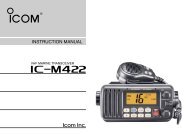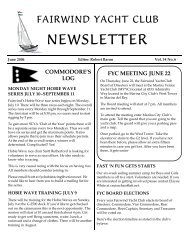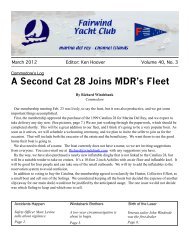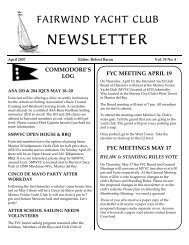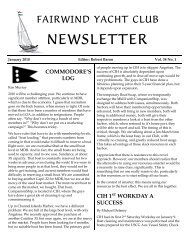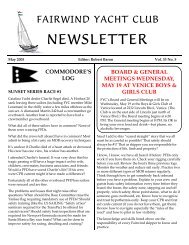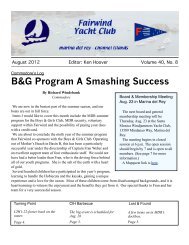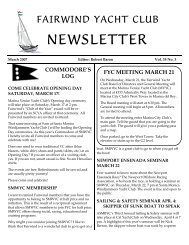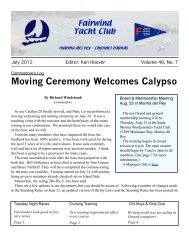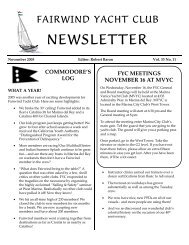August 2013 Newsletter - Fairwind Yacht Club
August 2013 Newsletter - Fairwind Yacht Club
August 2013 Newsletter - Fairwind Yacht Club
Create successful ePaper yourself
Turn your PDF publications into a flip-book with our unique Google optimized e-Paper software.
Note that depending on the wind direction, you may have to tack up the main channel, then lower the main<br />
sail if your slip is downwind in a north wind.<br />
Sailing with the jib alone, sail down the channel towards the dock area where your boat belongs. As you<br />
come down the channel towards your dock, point your boat in the same direction you will be entering the slip<br />
and practice letting go the jib lines or furling the jib to estimate the amount of time it will take for your<br />
momentum to slow enough to safely enter the slip. This will give you an idea of how soon to let the jib sheets<br />
go as you approach the finger to be able to coast down the finger and into the slip and stop the boat without<br />
running the bow into the dock.<br />
If you feel there is too much momentum and too strong a breeze coming from astern that could prevent you<br />
from safely docking, do not enter the finger to your slip. Instead locate an empty upwind or end tie slip that is<br />
close to your slip that you can safely enter and bring the boat to a stop. The guest docks just past the boat<br />
launch ramp are always a good alternative. Always alert the harbormaster and the boat chief if you have to<br />
leave a boat in a slip other than its own.<br />
Upwind Docking<br />
When docking upwind you should have the ability to luff all the sails when pointed upwind, which should be<br />
the same direction that you enter the slip at. This is similar to a man overboard where you would coast<br />
upwind and your momentum is just enough to get into the slip without running the bow into the end of the<br />
slip. Just outside your docking area is a good place to judge the direction and speed of the wind since it may<br />
be different than out in the main basin.<br />
In the main channel, you can furl the headsail, attach your fenders and dock lines and use just your main to<br />
come down the channel to your docking area. Again, as you approach your finger, point the boat in the same<br />
direction you will be entering the slip, ease the mainsheet and judge the direction of the wind to make sure<br />
you will be able to luff the sail and coast into the slip. If you feel there is too much wind and may have too<br />
much momentum, do not enter the finger to your slip area and locate a better slip or end tie or guest dock to<br />
dock the boat.<br />
One of the pitfalls of docking with the main alone is as you turn down your finger you can be at a beam<br />
reach and not be able to luff your sail sufficiently and you could gain excess momentum as you approach your<br />
slip. If this were the case then I would dock under jib alone as you can let the jib sheets out all the way or<br />
partially furl the jib to reduce sail area. Again estimate your approach in the channel and decide if you can<br />
successfully coast into the slip and come to a stop without running the bow into the end of the slip.<br />
Mark Zierten presents Commodore<br />
Richard Windebank with a handmade<br />
gavel during a dockside<br />
birthday party. Helping out is Roy<br />
Niebuhr.<br />
10



